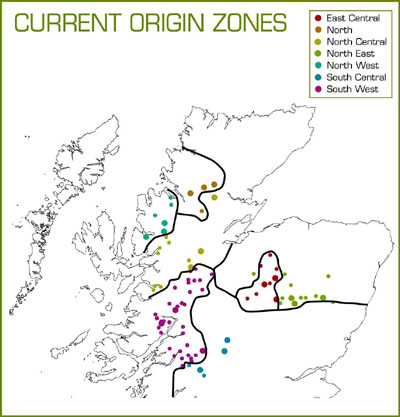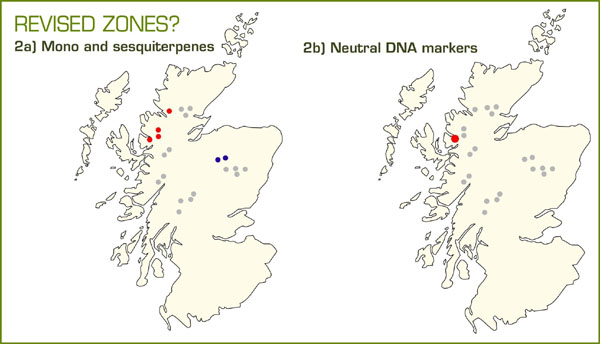Appraisal & Revision Of Genetic Conservation Of Our Caledonian Pinewood
Published on 16 March 2010 in Sustainability and Communities , Ecosystems and biodiversity
Introduction
Caledonian Scots pine woods cover less than 1% of their previous extent and are protected under the EC Habitats Directive. Scotland has 100% of the UK Caledonian pinewoods, which persist in 84 small fragments, the core areas of which range from 1-2500ha. Current guidelines for the conservation of British tree species recommend that any planting stock should be derived from local seed sources, assuming that it is best suited to that particular local environment.
For Scots pine, seven ‘origin zones’ have been identified based upon the relatively small proportion of variation between populations in the monoterpenes, a group of genetically heritable volatile plant secondary metabolites, previously commonly used as genetic markers (Fig. 1). However since the identification and adoption of the Scots pine origin zones in the 1980s there have been considerable advances in analysis of both these chemicals and of genetic material (DNA) that permits direct identification of the genotypes of Scots pines. This . We also suggest alternative more robust bases for identification of the origin zones of Scots pine in the light of current climatic trends.
Key Points
Our analysis shows little support for the current seven origin zones of Scots pine, either on the basis of the biochemical analysis (which identifies two zones that are distinct from the remainder – 1) in the North-West of Scotland and 2) another group comprising the Abernethy and Rothimurchus populations (Fig. 2a) or molecular DNA markers (for which only the Shieldaig population in North-West Scotland appears to be different from the others Fig. 2b).
The growth characteristics and timing of bud burst vary between the seven origin zones and between the populations within them. Initial results suggest that at the larger regional scale of the seven current origin zones, growth or other adaptive characteristics may form a superior basis on which to classify and conserve our populations of Scots pine.

Figure 1: Map showing the seven current origin zones for Scots pine. Larger dots show the 21 study populations, three in each zone.

Figure 2: Maps showing which of the 21 study populations were distinct from the others, based on revised analysis of a) pine needle mono- and sesquiterpenes Two groups were identified as being distinct from the others. One included three ‘Northwest’ zone populations (red dots:Shieldaig, Ben Eighe and Loch Clair combined with Rhiddoroch in the ‘North’ zone); and the other distinct group comprised Abernethy and Rothiemurchus (blue dots). and b) Neutral genetic markers; only Shieldaig was distinct from the others.
Research Undertaken
We collected and analysed pine needle samples from 30 trees in each of 21 of our original native Caledonian pinewoods (three populations in each of the seven current origin zones). We applied principal components analysis to identify the variation between the Scots pine populations after using the latest techniques for the analysis of mono- and sequiterpenes and newly developed DNA markers.
The biochemical markers are also known to mediate many of the ecological interactions between Scots pine and the other plants and animals that are dependent on it, and it would be appealing to retain this as a basis for conservation action via assignation of ‘origin zones’. However, these biochemicals are very variable between trees within a population and do not show enough variation between populations to be reliable for this purpose. There is a similar absence of useful variation in the molecular DNA markers, which are selectively neutral and are not differentiated between the populations except for the Shieldag population. We are currently considering whether and over what spatial scale, Scots pine trees differ from each other with respect to growth characteristics of seedlings and their timing of bud burst and cessation of growth. These adaptive characters are among those that may influence the survival, growth and associated biodiversity of the trees under different climatic regimes. Seedlings from the 21 populations (3 in each of the 7 origin zones) were produced and grown under the contrasting conditions at two sites, one on the East coast of Scotland (Aberdeen: Cool, dry climate), and one in the North-west of Scotland (Inverewe: warm, wet climate). In nine out of ten growth characteristics, there was significant variation between origin zones. However only three of these characteristics, namely stem diameter, date of bud burst and number of buds set, the responses varied between the two climatic regimes under which they grown, although these responses were small, particularly for the date of budburst.
Policy Implications
The conservation of Scots pine itself is important for the UK and Scottish Government’s obligations for an Annex 1 species of the EC Habitats Directive. However, the entire Caledonian pinewood system is also home to other rare species of plants and animals, adding to its overall conservation significance. The regeneration and re-establishment of Caledonian pinewood also represents a worthy goal as part of overall forest production and carbon sequestration strategies. However, Scots pine conservation and re-afforestation strategies need to be informed by sound genetic conservation principles, in order to ensure the sustainability of pinewoods under climate change. The molecular markers (DNA) do not represent characteristics of the trees that may affect their survival or reproduction. Neither biochemical nor molecular markers show the population level differentiation needed to contribute to a comprehensive conservation strategy. As an alternative we should consider whether characteristics of trees, such as growth or the timing of bud burst form a better basis to investigate and classify differences between our Scots pine populations.
Further research work is needed to quantify the tolerance of the Scots pine from different origins to different climatic conditions in order to ensure the long-term persistence of regenerating populations under changing climatic regimes.
Author
Dr Glenn Iason (MLURI), Dr Ben Moore (MLURI) Dr Joanne Russell (SCRI), Dr Richard Ennos (University of Edinburgh), Dr Pete Hollingsworth (RBGE) g.iason@macaulay.ac.uk
Topics
Sustainability and Communities , Ecosystems and biodiversity







